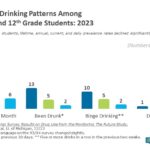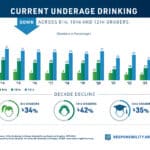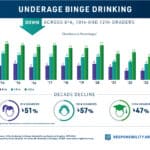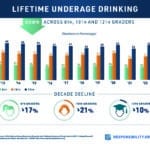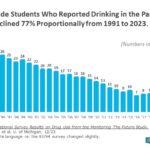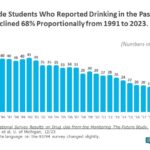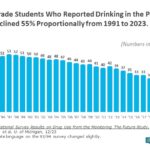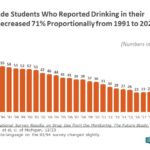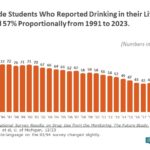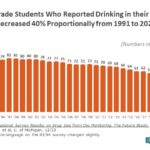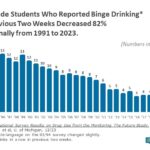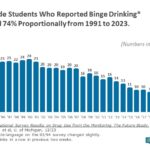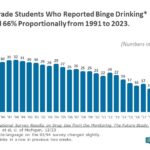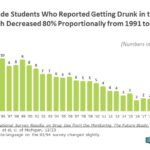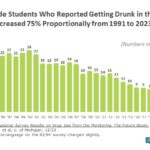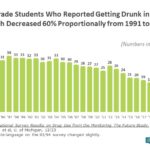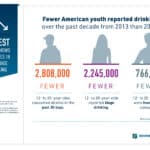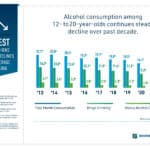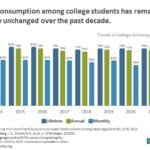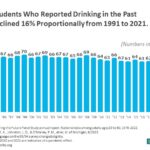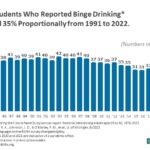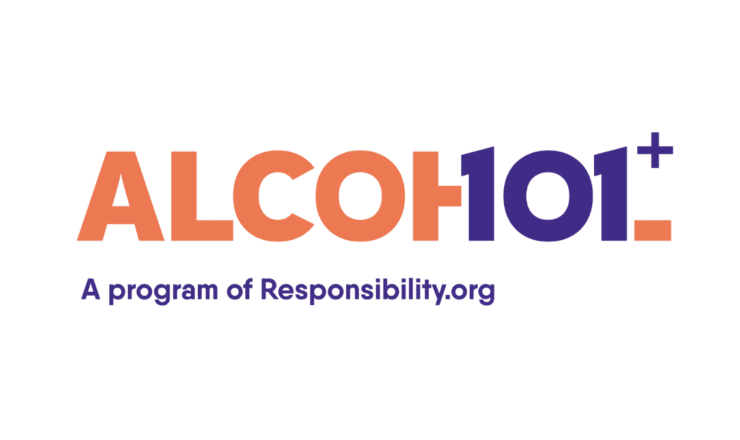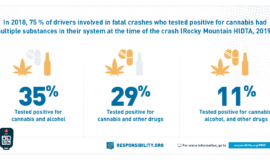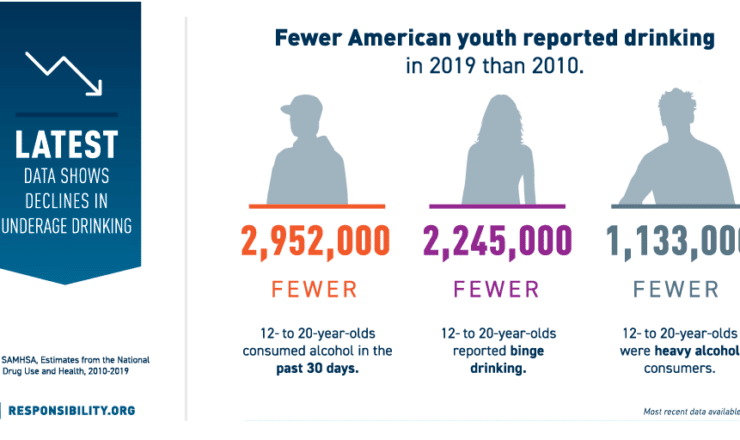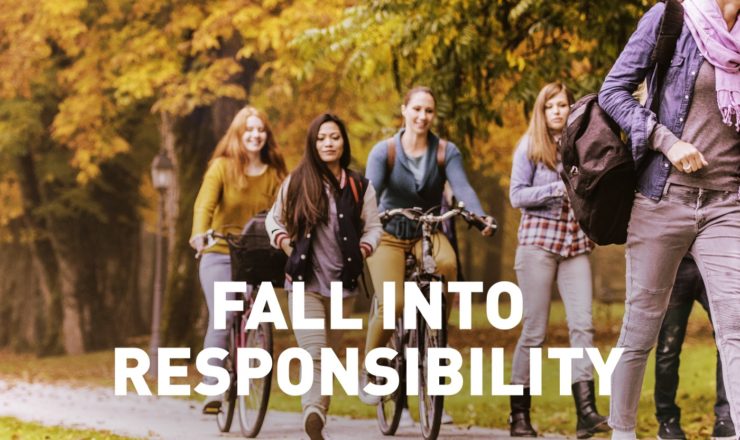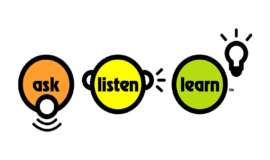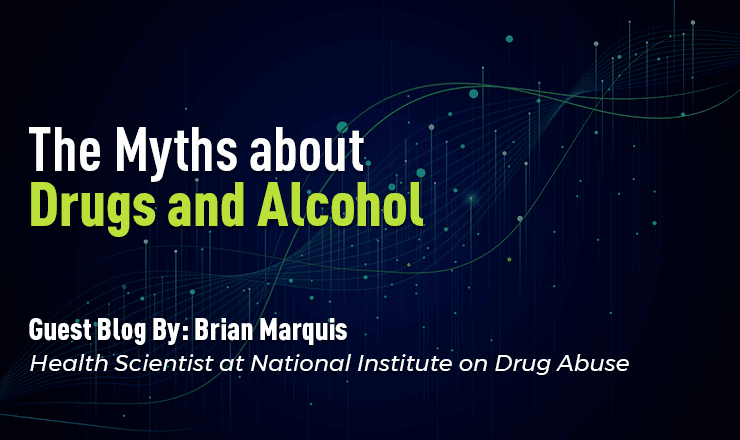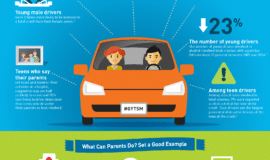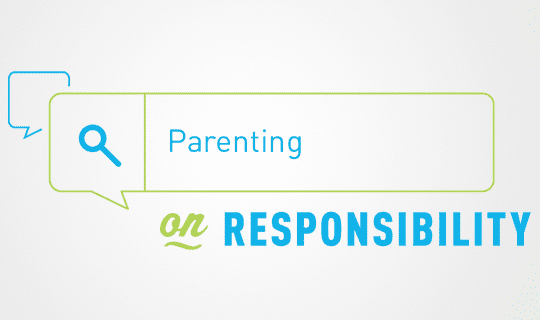The Fight Against Underage Drinking | Stats on Teen Alcohol Use
Though progress is being made, underage drinking remains a persistent problem. According to the 2022 National Survey on Drug Use and Health (NSDUH) report, about 5.8 million Americans between the ages of 12 and 20 report current alcohol consumption; this represents 15% of this age group for whom alcohol consumption is illegal. Among 12- to 20-year olds, reported rates of lifetime, past month consumption, binge drinking, and heavy alcohol consumption have declined steadily from 2013 to 2022, reaching or near historic low levels in 2022.
Early drinking is a risk factor for alcohol use disorders. Adults who had taken their first drink of alcohol before the age of 15 were 6.5 times more likely to experience an alcohol use disorder than those who didn’t start drinking before age 21. (SAMHSA, 2017 NSDUH).
The 2023 Monitoring the Future study found that alcohol consumption among America’s teens is at or near record low levels. For the three grades combined (8th, 10th, and 12th) the proportion of students reporting lifetime, annual, current (past 30-days), and binge drinking (36 percent, 30 percent, 14 percent, and almost 6 percent, respectively) are below pre-pandemic prevalence rates.
Among 12th grade students, lifetime, annual, current, and daily prevalence rates declined significantly from 2022 to 2023. The 2023 decrease in underage alcohol consumption among high school seniors contrasts with the increase in lifetime, past year, and daily use noted in 2022. This year’s noted declines in underage drinking among 12th graders are a delayed effect of the pandemic, as these students were 9th graders in 2020 when schools closed as a result of the pandemic. These prevalence rates are significant in that they demonstrate the potential lifetime reduction in substance use by delaying the onset of alcohol and other substances by a single year.
Underage Drinking--National Survey Results
College Drinking-National Survey Results
Gender Differences in Alcohol Consumption
Where Youth Get their Alcohol
Underage Drinking - National Statistics
For more than 30 years the Foundation for Advancing Alcohol Responsibility has been leading the fight to eliminate drunk driving and underage drinking. While rates have declined, alcohol consumption among youth under the legal drinking age remains a concern.
The rate of current alcohol consumption increases with increasing age according to the 2022 National Survey on Drug Use and Health from almost 2% among 12-13 year olds to nearly 15% at ages 16-17, and almost 32% among 18-20 year olds.
- Fewer American teens are drinking than ever before, reaching new lows in 2023.
- Eighty-six percent of teens have not consumed alcohol in the past 30 days.
- Harmful consumption continues to decline. From 2014 to 2023, binge drinking decreased 51% among teens in 8th, 10th, and 12th grades.
- Six out of ten American teens have never consumed alcohol, a clear indication of success in delaying the onset of underage drinking.
Monitoring the Future
The majority of American teens do not drink alcohol, and the long-term declines noted over the past few decades continued in 2023. As noted in the 2023 Monitoring the Future survey, lifetime, annual, past month consumption, and binge drinking levels are below pre-pandemic levels and at or near historic low levels - 64 percent of American teens report they have never consumed alcohol in their lifetime. Peer disapproval of binge drinking remains high among 8th, 10th, and 12th graders in 2023.
An unintended but positive consequence of the COVID-19 pandemic was unprecedented declines in underage alcohol consumption among American teens. In 2023, the rates of underage drinking among students in 8th, 10th, and 12th grades rates remained relatively unchanged and significantly lower than peak years recorded in the early to mid-1990s when tracking of this data began.
One in seven teens (14%) report consuming alcohol in the past 30 days. Current alcohol consumption among students in all three grade levels combined reached an historic low in 2023, having declined 37 percent since 2014 and 64 percent since 1991. At the individual grade levels, past month consumption remained relatively unchanged among 8th and 10th grade students between 2022 and 2023 but declined significantly among high school seniors.
- Past month consumption among eighth graders continues to decline steadily, reaching a record low six percent, having decreasing 34 percent over the past ten years.
- One in seven 10th graders report current alcohol consumption (14%), declining 42 percent from 24 percent in 2014.
- One in four 12th graders report consuming alcohol in the past 30 days, an historic record low level in 2023. Current drinking among high seniors is down 35 percent over the past decade from 37 percent in 2014 to 24 percent in 2023.
- Past month consumption among 8th graders continues to experience modest by steady long-term declines. Six percent report current alcohol consumption, down 34% over the past decade.
- One in seven 10th graders report drinking alcohol in the past 30-days, declining 42% from 24% in 2014 to 14% in 2023.
- Twenty-four percent of high school seniors report current alcohol consumption. Past month consumption among 12th graders has declined 35% since 2014 and 55% since 1991.
Among teens in grades 8, 10, and 12 combined, the majority (64 percent) report they have never consumed alcohol in their lifetime. Over the past decade the number of combined students reporting they have consumed alcohol decreased 23 percent, proportionally, and 55 percent from a record high of 80 percent in 1991. Eight out of ten (80 percent) of 8th graders report they have never consumed alcohol, with 20 percent reporting they have consumed alcohol at least once in their lifetime. Lifetime consumption among eighth-graders is down 71% proportionally from 70% in 1991. Lifetime consumption of alcohol declined significantly among tenth graders and twelfth graders from 2022 to 2023. Sixty-four percent of 10th graders have never consumed alcohol in their lifetime, a decrease of 57 percent, proportionally, from 1991, and 27 percent since 2014. Additionally, 47% of high school seniors report they have never consumed alcohol, down 40 percent, proportionally, from a high of 88 percent in 1991, and declining 20 percent over the past ten years.
.
- Lifetime consumption declined 25% from 2014 to 2023, with one in five 8th graders reporting they have consumed alcohol.
- The majority (64%) of 10th graders have not consumed alcohol. Lifetime consumption among 10th graders decreased significantly from 2022 to 2023, and 27% since 2014.
- By the time a student reaches their senior year in high school slightly less than half (47%) have never consumed alcohol. Lifetime consumption among 12th graders declined 20% over the past decade and 40% since 1991.
In 2023, annual consumption rates remained relatively unchanged among 8th and 10th grade students but declined significantly among 12th grade students. Among all three grade levels combined, the prevalence rate of past year consumption decreased a significant 2.2 percentage points from 32.2% in 2022 to 30.0% in 2023. At the individual grade level, annual consumption was well below pre-pandemic levels - 15% among 8th graders, 31% among 10th graders, and 46% among 12th graders - declining 72% proportionally among 8th graders, 59% among 10th graders, and 41% among 12th graders since record-keeping began in 1991. From 2022 to 2023, annual alcohol consumption among 12th graders decreased significantly 12% proportionally from 52% to 46%.
- Fifteen percent of eighth graders report consuming alcohol in the past year, down 27% proportionally from 21% in 2014.
- Nearly one in three (31%) of 10th graders report consuming alcohol in the past year, a decrease of 30% proportionally from 44% in 2014.
- Twelfth graders’ reported annual consumption rate decreased significantly from 2022, reaching a record low level. The prevalence rate of past year consumption among high school seniors has declined 24% proportionally from 60% in 2014 to 46% in 2023.
Overall substance use among teens in 2023 remained below the pre-pandemic levels reported in 2020. Underage binge drinking (defined as having five or more drinks in a row in the past two weeks) continued to remain below pre-pandemic levels, continuing its long-term decline. Among 8th, 10th and 12th graders combined binge drinking declined, with less than six percent reporting they have engaged in this level of harmful consumption. Binge drinking has declined 51 percent proportionally from 2014 to 2023 and 72 percent since 1991.
- Two percent of 8th graders reported binge drinking in 2023, a decrease of 82 percent from 1991, and 51 percent from 2014 to 2023.
- Five percent of 10th graders engaged in binge drinking, down 57 percent from 13 percent in 2014, and 74 percent since 1991.
- One in ten 12th graders (10 percent) report consuming five or more drinks in a row, a 47 percent decrease from 19 percent, proportionally, in 2014, and 66 percent from 1991 to 2023.
- 80% of 8th graders disapprove of binge drinking. Given this high level of peer disapproval it is not surprising that less than 2% of 8th graders reported binge drinking, down 51% since 2014
- One in 20 10th graders said they engaged in binge drinking, down 57% from 13% in 2014. Fifty-four percent of 10th graders perceive binge drinking to be a great risk.
- Two-thirds (66%) of high school seniors disapprove of binge drinking. In 2023, 10% of 12th graders report consumng five or more drinks in a row in the previous two weeks.
According to the 2023 Monitoring the Future study the proportion of students reporting they have been drunk in the past 30 days reached an all-time record low - decreasing significantly among 12th graders in 2023. The long-term trend of American teens reporting they have been drunk in the past month has continued to decline – since 1991 the rate among students in all three grades combined is down 68% proportionally from 19% in 1991 to 6% in 2023, and down 48% over the past decade down from 12% in 2014.
- Less than 2% of 8th graders report having been drunk in the past month. Eighth grade students who reported getting drunk in the past 30 days decreased 44% over the past decade, and 80% since 1991.
- Tenth graders who reported getting drunk in the past month has declined 75% proportionally from 1991 to 2023. However, about 1 out of every 20 tenth graders still say they have been drunk in the past month.
- Nearly 88% of high school seniors have not been drunk in the past month, with less than 13% reporting they have engaged in this behavior. The rate of 12th graders reporting they have been drunk has declined 47% over the past ten years.
(Source: NIDA, National Survey Results on Drug Use from 2023 Monitoring the Future Study, 1/2024)
National Survey on Drug Use and Health
According to the 2022 National Survey on Drug Use and Health (NSDUH), about 6 million Americans between the ages of 12 and 20 report current alcohol consumption; this represents 15% of this age group for whom alcohol consumption is illegal.
Over the past decade, the National Survey on Drug Use and Health surveys have shown a decline in the prevalence rates of current, binge, and heavy alcohol consumption among 12- to 20-year olds, including nearly 2.8 million fewer underage drinkers and more than 2.2 million fewer binge drinkers since 2013.
- Past month consumption among 12- to 20-year olds has declined 33 percent proportionally from 23% in 2013 to 15% in 2022. Current consumption among underage persons is at an all-time record low.
- Underage binge drinking (four/five or more drinks (female/male) on the same occasion on at least one day in the past month) rates decreased 39 percent proportionally from 13% in 2015 to 8% in 2022, reaching an historic low.
- Heavy drinking (five or more drinks on the same occasion on 5 or more days in the past 30 days) remained relatively unchanged in 2022, with 1.7 percent of 12- to 20-year olds self-reporting engaging in this behavior, however, the prevalence rate has declined nearly 49 percent proportionally from 3.3% in 2015. (Source: SAMHSA, 2022 National Survey on Drug Use and Health, 11/2023)
- While fewer American youth report drinking in the past month, the 5.8 million current drinkers, for whom alcohol is illegal, is still too many. Help us prevent underage drinking.
- Most youth don’t drink and alcohol consumption among the nation’s youth continues to decline gradually
College Drinking - National Survey Results
According to the 2022 Monitoring the Future Panel Study, alcohol consumption among college students has declined slightly over the past decade. Alcohol prevalence rates declined significantly in 2020 after the pandemic, and significant rebound increases were recorded in 2021. The Monitoring the Future Survey revealed in 2022 these prevalence rates have leveled off and returned to at or near pre-pandemic levels, with long-term trends in alcohol consumption among college students having decreased slightly but are fairly flat over the past decade.
Overall, the prevalence of college drinking over the past 30 years, measured as lifetime, annual, and past 30-day consumption rates continues to trend downward. Since 1991, monthly consumption among college students has declined 17% proportionately, while binge drinking declined 35%.
In 2022, four out of five college students (80.5 percent) report they consumed alcohol in the past 12 months and 63 percent report consuming alcohol in the past 30-days. However, after reported pandemic-related rebound increases in harmful consumption in 2021, rates of binge drinking and high-intensity drinking have declined in 2022.
- In 2022, more than one in four college students report engaging in binge drinking (having five or more drinks in a row in the past two weeks). However, the prevalence of binge drinking among college students declined 11 percent proportionally, from 31.2 percent in 2021 to 27.7 percent in 2022.
- Binge drinking had typically been more prevalent among college than noncollege young adults over the years, but in 2022 there was no significant difference.
- High-intensity drinking (consuming 10 or more drinks in a row at least once in the past two weeks) declined significantly from 2021 to 2022. One in twenty college students (5.2 percent) said they consumed 10 or more drinks in a row compared to 10.5 percent in 2021.
- College men were two times more likely to report having engaged in high-intensity drinking than their college women peers (8% and 3.4%, respectively).
(Source: University of Michigan, Monitoring the Future Panel Study annual report: National data on substance use among adults ages 19 to 60, 1976-2022, 8/2023)
- Trends in college drinking remain relatively unchanged over the past decade.
- Current drinking among college students decreased 17% from 1991 to 2022.
- Binge drinking among college students decreased nearly 10% proportionally from 2021 to 2022.
- 1 in 3 college students report getting drunk in the past month, increasing significantly from 2020 to 2021.
Gender Differences in Alcohol Consumption
According to the the 2022 National Survey on Drug Use and Health (NSDUH) nearly 5.6 million 12- fo 20-year old girls reported consuming alcohol in the past year.
In 2022, females aged 12 to 20 reported higher rates of past year consumption than their male peers (29.9% v. 26.8%, respectively), as well as past month alcohol consumption, (16.5% females v. 13.8% males), and binge drinking (8.9% females v. 7.5% males), however, males reported slightly higher rates of heavy alcohol consumption (1.9% males vs. 1.4% females, respectively). Among 12- to 17-year olds, decreases in the prevalence rates of past year and past month alcohol consumption, binge drinking, and heavy drinking from 2021 to 2022 were noted among males and females, however, a statistically significant decrease was noted in past year consumption among 12- to 17-year old females from 21.5% in 2021 to 18.9% in 2022. Similar to their older peers, 12- to 17-year old females report higher rates of past year drinking, current alcohol consumption, and binge drinking compared to their male peers in 2022. Heavy alcohol consumption rates remain low among both males and females (0.2% for both). These noted gender gaps in alcohol consumption remained relatively unchanged between 2021 and 2022 among 12- to 20-year olds, and 12- to 17-year olds. (Source: SAMHSA, 2022 National Survey on Drug Use and Health, 11/2023)
The 2021 Monitoring the Future Panel Study reports among college students in 2021, college men and women reported similar rates consumption in the past 30-days (59%), however, among their non-college peers past month consumption while lower was higher among women than men (50% and 46%, respectively. Harmful binge drinking defined as having consumed five or more drinks in a row during the previous two weeks was higher among college men (34%) than college women (29%). Rates of extreme binge drinking (10 or more drinks) indicate a significantly larger variance by gender in 2021 with three times more college men reporting they participated in this level of extreme of drinking compared to college women.
- College men were three times more likely than college women to report having engaged in high intensity drinking, that is, having 10 or more drinks in a row in the past two weeks (18% and 6%, respectively).
- Compared to their non-college age peers, men were twice as likely to report consuming 10 or more drinks in a row in the last two weeks than their women peers (21% and 11%, respectively).
(Source: University of Michigan, Monitoring the Future Panel Study annual report: National data on substance use among adults ages 19 to 60, 1976-2021, 8/2022)
Where Youth Get Their Alcohol
According to the 2022 National Survey on Drug Use and Health (NSDUH) nearly half of current underage drinkers ages 12 to 20, who consumed alcohol in the past month, report the last time they drank alcohol it was either at their own home (47%) or in someone else's house (42%). Additionally, seven out of ten of these underage drinkers said they were drinking with more than one other person the last time they drank.
Family and friends continue to be a leading source of alcohol for today’s youth. Seventy-two percent of current underage drinkers said they did not pay for the alcohol they consumed the last time they drank. The most frequently cited source of alcohol was an unrelated person aged 21 or older (28%), followed by family and friends. More specifically, their own parents/guardian (17%), another adult family member 21 or older (16%), another underage person (15%), took from home (11%), took from someone else’s home (2%).
Influence of Parents
Despite being identified by youth as one of their primary sources of alcohol, hands down, parents are the most influential person or thing in a child’s decision not to drink at all or not to drink on occasion.
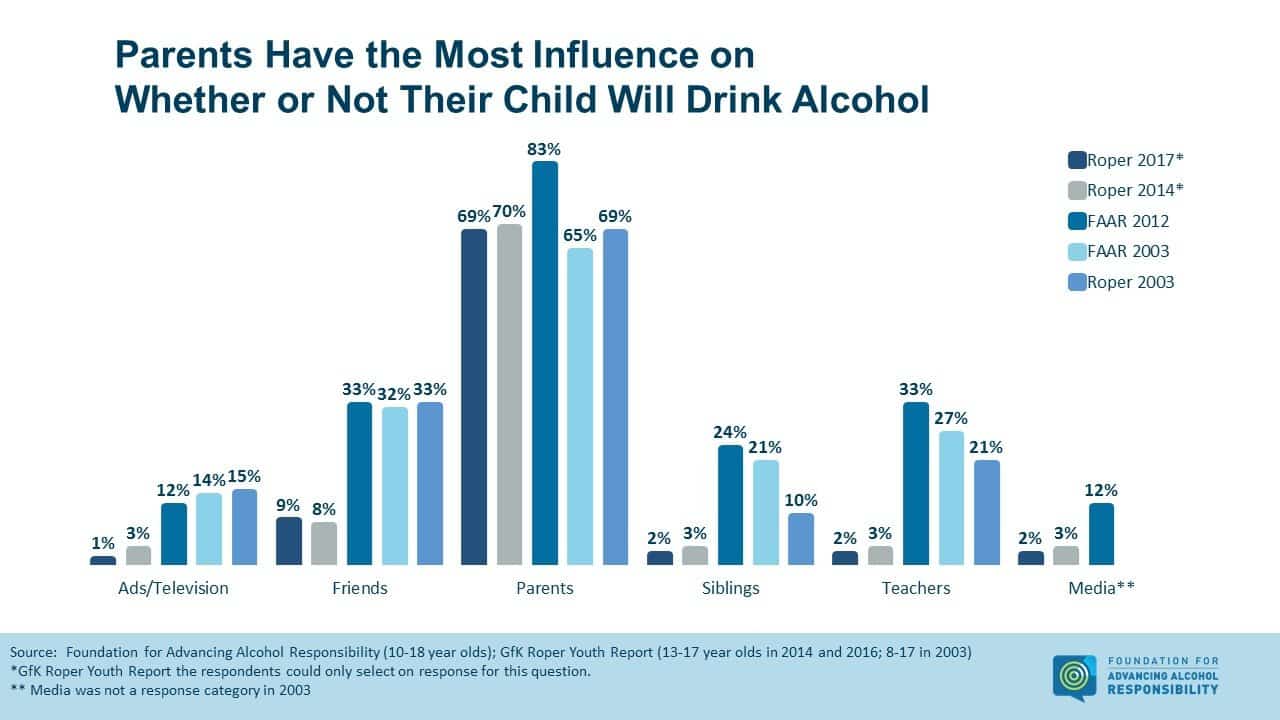
Additional research from the Centers for Disease Control’s 2019 Youth Risk Behavior Survey reported that 41% of students who reported past-month consumption said that they usually obtained the alcohol they drank by someone giving it to them; the prevalence of having someone give them alcohol was higher among females (45%) than males (35%).
Regardless of the source of alcohol, youth report access to alcohol is easy. According to the 2021 Monitoring the Future survey 77% of 12th graders, 60% of 10th graders, and 48% of 8th graders say it be "fairly easy" or "very easy" for them to get alcohol. On a positive note, despite reported ease of obtaining alcohol disapproval of binge drinking continues to remain high among all three grade levels (8th, 81%; 10th, 78%; 12th, 58%).

